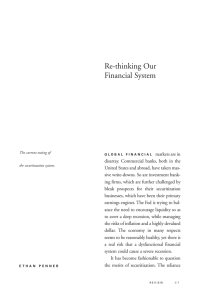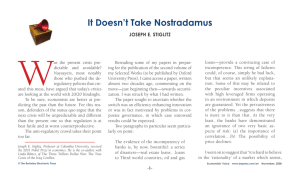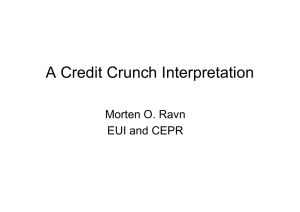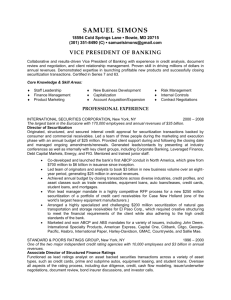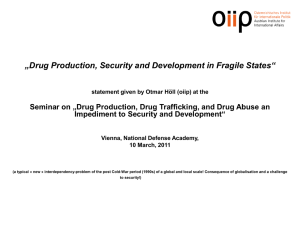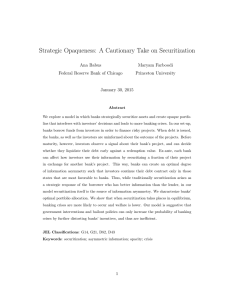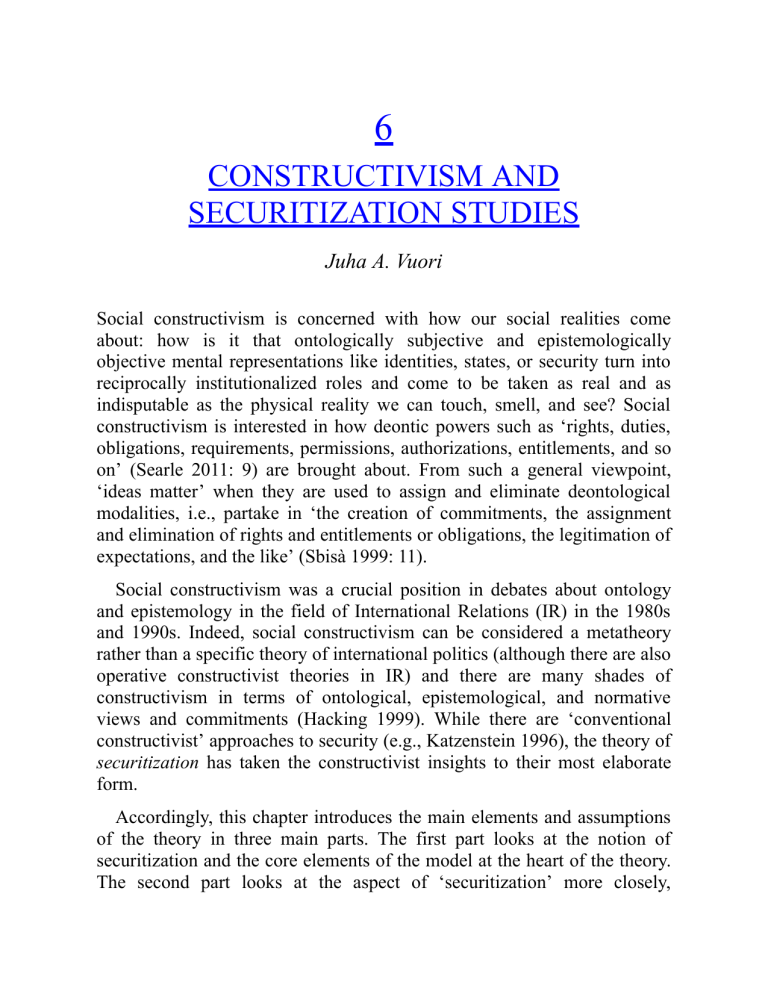
6
CONSTRUCTIVISM AND
SECURITIZATION STUDIES
Juha A. Vuori
Social constructivism is concerned with how our social realities come
about: how is it that ontologically subjective and epistemologically
objective mental representations like identities, states, or security turn into
reciprocally institutionalized roles and come to be taken as real and as
indisputable as the physical reality we can touch, smell, and see? Social
constructivism is interested in how deontic powers such as ‘rights, duties,
obligations, requirements, permissions, authorizations, entitlements, and so
on’ (Searle 2011: 9) are brought about. From such a general viewpoint,
‘ideas matter’ when they are used to assign and eliminate deontological
modalities, i.e., partake in ‘the creation of commitments, the assignment
and elimination of rights and entitlements or obligations, the legitimation of
expectations, and the like’ (Sbisà 1999: 11).
Social constructivism was a crucial position in debates about ontology
and epistemology in the field of International Relations (IR) in the 1980s
and 1990s. Indeed, social constructivism can be considered a metatheory
rather than a specific theory of international politics (although there are also
operative constructivist theories in IR) and there are many shades of
constructivism in terms of ontological, epistemological, and normative
views and commitments (Hacking 1999). While there are ‘conventional
constructivist’ approaches to security (e.g., Katzenstein 1996), the theory of
securitization has taken the constructivist insights to their most elaborate
form.
Accordingly, this chapter introduces the main elements and assumptions
of the theory in three main parts. The first part looks at the notion of
securitization and the core elements of the model at the heart of the theory.
The second part looks at the aspect of ‘securitization’ more closely,
considering meanings of security, the normative underpinnings of
securitization theory, and what ‘successful’ securitization entails. The third
part tackles the question of what kind of ‘theory’ securitization theory is,
paying particular attention to the distinction between a theory and a
theoretical framework, and how securitization theory can be applied to
different empirical cases.
The theory of securitization: the basics
The notion of securitization captures the performative power politics of the
concept ‘security’ and has shown how issues acquire the status of security
through intersubjective socio-political processes. Although many things can
threaten the existence of valued referent objects, such threats do not come
with labels – they require political action to gain the deontic rights, duties,
obligations, requirements, and authorizations that come about by
‘performing and getting others to accept’ (Searle 2011: 85) securitization
speech acts. The aim of securitization studies is to gain an increasingly
precise understanding of who (securitizing actors) can securitize (political
moves via speech acts) which issues (threats), for whom (referent objects),
why (perlocutionary intentions/how-causality), with what kinds of effects
(inter-unit relations), and under what conditions (facilitation/impediment
factors) (Vuori 2011a: 7).1
Securitization theory was an answer to the broadening and deepening
debates about security in the late 1980s; it is possible to widen the study of
security without rendering everything as security by fixing on the form of
security speech and by viewing security as a status and modality. For Ole
Wæver, the original developer of securitization theory (Wæver 1989a,
1995), ‘one could “throw the net” across all sectors and all actors and still
not drag in everything with the catch, only the security part’ (Wæver 2011:
469). This was achievable through a focus on particular speech acts, where
securitizing actors claimed existential threats to valued referent objects so
that audiences would accept, or at least not oppose, extraordinary measures
that would otherwise not be acquiesced.
Such social construction of threats, and remedies for them, was
considered an effective means to gain legitimacy for unpalatable policies
that broke the rules of everyday politics. In this sense, the approach
combines the study of what securitization does (what it ‘triggers’) with
political constellations, or who or what does securitization (what ‘triggers’
it) (Guzzini 2011: 336–7). The effects of securitization on society, process,
and polity can be studied in three stages (Wæver 2014: 28), where
1. Aspirations of actors are related to societal conditions;
2. Political codifications that constitute particular relationships are
analysed through speech act theory;
3. Effects on political, legal, and socio-psychological life are examined.
The theory of securitization models the way we have learned to understand
what security is and what counts as security, as well as how something
becomes security and what security does. The theory allows for different
kinds of analysis of the distinct political move: the ‘causal analysis’ of its
consequences, the ‘sociological analysis of social patterns that condition
political possibilities’, and the political theorization of ‘life under different
arrangements’ (Wæver 2014: 31). In this way, the notion of securitization
denotes the process of creating social facts, statuses, and modalities of
security. The model contains several important elements (Buzan et al.
1998): the general script or plot of security entails priority and utmost
importance of the particular issue; the existence of a valued referent object
is at stake and under threat. The model as such has seven variables:2
1. A securitizing actor (that which or who makes the move towards a new,
or to alter an existing, issue of security in accordance with particular
conventions and grammars);
2. A referent object (that which is to be secured);
3. A threat (that which threatens the referent object);
4. An audience (the necessary relation needed to produce the deontic
modality of security or those who have to be ‘convinced’ for
securitization to be satisfied);
5. Felicity conditions (rules and conventions of the speech act and its
consequences);
6. Facilitation factors (factors that can facilitate or impede the acceptance
of the securitization move; social conditions that relate to social
positions of the actor and audience as well as the threat);
7. Functional actors (actors that are neither the securitizing actor, the
threat, nor the referent object, but still have some bearing on the
process).
The model has speech act theory at its core: the theory of securitization
‘was built from the start on speech act theory, because it is an operative
method’ (Wæver 2014: 27). This is an opportune foundation for a theory of
social construction, as speech acts are taken to be the basic form of human
communicative interaction in speech act theory (Searle and Vanderveken
1985). The basic idea here is that people do things by talking, that they
perform different kinds of acts by speaking (Austin 1975).3 Language is not
used merely to convey information; it is for example used to explain
(assertives), order (directives), threaten (comissives), thank (expressives),
and declare things, e.g. war (declarations) (Searle and Vanderveken 1985).
Such acts can be analysed through three types or aspects of speech acts
(Austin 1975):
• Locutionary (an act of saying something with a sense and a reference);
• Illocutionary (an act in saying something);
• Perlocutionary (an act by saying something).
Speech act theory suggests that people interact with the language they use
by infusing it with illocutionary forces, which are used to produce
(perlocutionary) effects in other people that can affect the feelings,
attitudes, and subsequent behaviour of the hearer(s). Such forces have
broader universality across languages than certain verbs of a particular
language. Yet illocutions, unlike perlocutions, are conventional: they are
done conforming to conventions that are historicized and dependent on
social and cultural factors (Austin 1975).4
What is securitization?
Securitization as a keyword or notion has become very enticing, even to the
degree that it is used in articles to do things without any references to the
securitization studies literature. There seems to be something selfexplanatory in the term as such, which may partly explain some of the
confusion in the critical literature on it. Other alternative terms that engage
similar phenomena, such as security framing or threat politics, do not
appear to have the same appeal as securitization. Intuitively, securitization
is about how security comes about.
As such, security means different things to different societies, as the core
fears of any group or nation are unique and relate to vulnerabilities and
historical experiences (Wæver 1989b: 301). Yet, despite this historical
contingency, security tends to be portrayed as something ‘good’, as being or
feeling safe from harm or danger, which corresponds with its everyday
(non-expert) meaning as something of positive value. Perhaps
paradoxically, in the realm of international politics, security is often
understood as a more negative concern, since it is about blocking unwanted
developments. Concomitantly, security arguments in effect reproduce
insecurities; security arguments tend to promise more than they can deliver.
Securitization and the ‘negative’ side of security
Securitization studies have highlighted this negative side of security and
participated in elucidating how, rather than being positive or good for all,
the increase of security for some means its sacrifice for others. Some have
suggested that this kind of a critical view entails an ‘escape’ from security
as such. Yet the approach does not aim at a ‘rejection’ of security
altogether, but merely to make security speech unable ‘to function in the
harmonious self-assured standard-discourse of realism’ (Wæver 1989a: 38).
Rather than a total escape from security, the point is to alter ‘security’ from
the inside by unmasking its operative logic and stripping away its innocent
appeal. Such a ‘cynical’ (Wæver 1989a: 52) or ‘sceptical’ (Wæver 2012a:
53) view of security turns security issues into political ones, and makes
their theorization ‘critical’. The intention is to handle security problems by
revealing their contingent nature and open them up for the evaluation of
political responsibility.
The normative push and political recommendation of such an approach is
‘less security, more politics’ and the development of ‘possible modalities’
for the desecuritization5 of politics (Wæver 1989a: 52): it is generally
(which can only be assessed in practice though) more conducive to treat
identities as identities, religion as religion, the environment as the
environment, and so on, and to engage their politics through the particular
modalities and rationalities of those fields rather than those of security. This
however does not entail a preference for insecurity: security is a situation
where there is a threat with measures against it, whereas insecurity is a
situation where there is a threat and no certain measures to counteract it
(Wæver 1995: 56). What is desirable is desecuritization, which leads back
to (or keeps an issue within; Bourbeau and Vuori 2015) a-security or nonsecurity – a situation where there is no threat and thus no need for
restrictive measures.
Such preferences link up with visions of the political and of politics
(Huysmans 2014). In terms of how politics is understood and what kinds of
political effects the theory of securitization has, there have been multiple
positions: those that take politics as the production of meaning, those that
treat it as a modern institutional organization, and those that view it as
ethical science (Gad and Petersen 2011). For Wæver (2011: 470), the theory
of securitization combines a Schmittian concept of security with an
Arendtian concept of politics, as it is ‘strung between Schmittian
(anti)political exceptions and an Arendtian co-creation’ (Greenwood and
Wæver 2013: 501). In other words, ‘the political conception of
securitization theory is inspired by Arendt, implemented through speech act
theory’ (Wæver 2014: 27, emphasis in original). This means that while
security tends to produce a depoliticizing effect, political and social
contexts cannot close off securitization or desecuritization. While many
security issues and policies are path-dependent (Bourbeau 2014), there is
always a possibility that something unexpected will take place. This is why
scholars and theories should not explain away the openness and ‘inbetweenness’ of politics (Wæver 2014).
The preference for less security and more politics stems from the
particular security politics of the late 1980s in Europe: to speak about
national security did particular things that were problematic in light of
democracy (and has continued to do so, even as the claimed threats have
changed). Accordingly, part and parcel of securitization studies has been the
genealogical study of how security has come to have such performative
power (Wæver 1989a: 14, 2012b, Stritzel and Vuori 2016). Indeed, security
has not had a uniform meaning or power even in Europe.
The contemporary usage dates to the early-to-mid twentieth century
when ‘national security’ combined two favourable notions, and became
political vogue after the Second World War. In the US, ‘reasons of state’
combined with sovereign immunity had meant that any state documents
could be deemed secret and there was no possibility to sue the state. By
restricting state secrets to issues of national security, what the new
illocutionary power of security did politically was to limit and specify state
power. It is at this conjunction that ‘speaking security’ began to do things it
had not done before (Wæver 2012b); the previous speech acts of ‘national
interest’ and ‘necessity’ ceased to work as effectively while ‘security’
attained a new (illocutionary) force and entailed a new kind of status
transformation with concomitant deontic rights, responsibilities, and
political functions. It is because of such features that securitization (and not
security as such) can be considered a ‘speech act’ (Wæver 1989a, 1995,
Vuori 2011a). If securitization moves are successful, the speaker is able to
‘break the rules’ (i.e., the regular deontic rights and responsibilities of a
particular field) that normally constrict behaviour and policies, and shift the
issue into the depoliticized area of utmost priority and urgency – to the high
politics of survival.6
Successful securitization and its consequences
What ‘success’ means has been one point of contestation within
securitization studies. Views have differed between whether it is enough to
garner potential support for security measures, or whether actual measures
need to be implemented. An ‘if {a,b,c}, then securitization happens, and
with it the defined effects {x, y, z}, typically involving some exceptional
measures’ causal diagram of securitization (Patomäki 2014) is, however,
problematic in Wæver’s (2014) view. This is because securitization is
neither necessary, nor sufficient, to achieve ‘security’ understood as a
policy or some means to repel an existential threat: threat perceptions,
securitizations, and security actions are indeterminate (see Vuori 2011a:
136–40 for the full argument). Yet, various combinations of these three
variables entail different costs for decision makers or securitizing actors.
For example, security action without legitimization in the form of
securitization may be costly in terms of trust or popular support. Indeed,
securitization is akin to raising a bet (Wæver 1995: 80), not in the sense of
betting being a speech act, but in securitization raising the political stakes of
an issue to a principled level of survival, or some other most vital interest
(Wæver 1989a: 43). Even successful securitization has its costs:
securitization is a ‘political move because it has a price’ (Wæver 1989a:
45). The difference between betting and securitization becomes apparent
with the realization that it is impossible to make a bet without betting, but it
is possible to do security without securitization speech acts. Thus, the core
point of interest is the intersubjective establishment of a security status for
an issue: threat perceptions, whether something is really a threat, or
measures to bring about security are not the main concern, even though they
may be of interest in the overall investigation that follows an examination
of securitization.7
This is why it is necessary to separate ‘success’ as the ‘happiness’ or
‘satisfaction’ of securitization speech acts (i.e. securitization moves) and the
concomitant status transformation of an issue (if the moves have such an
effect) from the ‘success’ of the politics of securitizing something: happy
securitization and the establishment of a security issue may yet lead to very
unfortunate political outcomes. At the same time, securitization speech acts
can always fail: securitization is ‘equally constituted by its possible success
and its possible failure – one is not primary and the other derived’ (Wæver
1989a: 45).8 Success relates to how the audience is conceptualized (Balzacq
2005, Léonard and Kaunert 2011).
In theoretical terms, securitization reconfigures the (necessary)
relationship of the speaker and audience (Wæver 2014: 29). Here, the
audience has to be such that this reconfiguration can provide the speaker
with what the particular strand of securitization (Vuori 2008, 2011a) seeks
to gain in terms of deontological modalities and statuses: securitization can
be about raising an issue onto the agenda, legitimating future or past acts,
control, or deterrence. In practical terms, successes and failures of such acts
are on a continuum (as in speech act theory): it is highly unlikely that entire
audiences will ever be fully and uniformly convinced by any political
speech acts, including securitization. Indeed, the questions of what suffices
to bring about a security status transformation, and what counts as
assuaging rhetoric that convinces people need to be distinguished. Someone
(e.g., a leader of a social movement or opposition party) may convince
thousands of the security status of an issue (with securitization moves to
raise the issue onto the agenda, Vuori 2008, 2010) yet fail to gain a deontic
status transformation for it. Indeed, audiences that grant moral support for
security policies may differ from those that can grant deontic powers
(Balzacq et al. 2015b).
What kind of theory is securitization theory?
As securitization is a theoretical notion, it becomes necessary to consider
what kind of a theory the ‘theory’ of securitization is, or should be: a metatheory, a philosophical theory, a constitutive or ontological theory, or an
empirical theory (Balzacq and Guzzini 2014: 2–3). Different views on this
have produced positions that argue for varying emphases. Which kind of an
understanding of theory and which version is selected to guide the
framework of a securitization study has a major heuristic bearing on how a
particular study is conducted (Vuori 2014).
In the debate between linguistic/discursive and practice-oriented
approaches some positions emphasize the technocratic mundane practices
and techniques of security professionals that enact and modulate limits of
the secure and insecure (e.g. Bigo 2002; Huysmans 2014), rather than the
speech act spectacles of high politics. The positional divides have also been
phrased as those between philosophical and sociological views (Balzacq
2011), where the latter focus on different aspects of the context and
structures of securitization processes in a sociological vein while the
original formulations of the theory were closer to a post-structuralist
position that highlighted the performativity and creativity of speech acts,
and contained both ‘internal’ and ‘external’ aspects in the ‘event’ of
securitization (Stritzel 2007: 366).
The constitutive (Buzan and Hansen 2009: 215) approach has organized
the theory around the illocutionary aspect of securitization as a
transformative event where the relationship of rights and duties is
reconfigured (Wæver 2014), while the non-positivist causal mechanism
approach of interpretivist process-tracing has investigated the how-causality
of why certain moves can be expected, some gain receptive audiences, and
why certain action-complexes may follow from securitization (Guzzini
2011; Patomäki 2014). Finally, securitization has also been viewed as a
theory of politics that allows for the combination of philosophical and
sociological investigation (Williams 2014) as well as an ethical theory of
security that can deem when securitization is justified (Floyd 2011).
If and when security is considered to be a social construction, would it
not suffice to study such processes like any other social construction of X?
Or, as such processes resemble framing (Watson 2012), could securitization
not be studied as the framing of X? Is securitization not just ‘an idealtypical model of a particular and limited-scale social mechanism’ (Patomäki
2014: 38), or ‘a distinct theory of discourse’ (Stritzel 2014: 51)? Why is
there a need for a specific theory of securitization?
The theory of securitization is more than the framing of threat politics.
Securitization theory is a theory of the event when a security status comes
about, i.e., a theory about when the deontic modality or status function of an
issue is transformed (which can be a very prolonged and gradual process).9
Yet, the theory is about more than just the social mechanisms involved in
such processes: Wæver’s (1989a, 1995) project has been to produce a
theory of the politics of speaking security, about the ‘power politics of a
concept’ (Buzan et al. 1998: 32), which takes the approach beyond
discourses and rhetoric ‘to a theory of political co-production between
multiple actors of social states’ (Wæver 2014: 28). Political status
transformations should be studied ‘neither in or by single actors nor as
socially determined and thereby unpolitical’ (Wæver 2014: 28): ‘politics is
a sphere of re-presentation of the social – it is not the social, nor can it ever
be’ (Wæver 1989a: 11). Securitization as just the social construction, frame,
or discourse of X would lose sight of the political aspects of securitization
theory, which must be avoided even when the theory is combined with
approaches to framing (e.g., Paltemaa and Vuori 2006), social mechanisms
(Guzzini 2011), or resonant values and threat images (Stritzel 2007, 2014).
Theory or theoretical framework?
It is important here to distinguish between a theory and a theoretical
framework, as it seems that the two have at times been confused in the
various debates around securitization studies. Individual theories are often
formulated to explain, predict, understand, or to criticize certain phenomena
or social structures. But a ‘theory on its own never predicts or explains’
(Wæver 2014: 30); it is used as a basis for comparing empirical instances
and to generate specific hypotheses; ‘when theories are applied to the
world, their elements require specification’, and no conclusions of the
social world can ‘be derived from a theory in the absence of such
intermediate steps’ (Kaplan 2014: 52). Indeed, particular theories can be
used to do many things in different situations. Theoretical frameworks on
the other hand tend to be particular to individual studies or pieces of
research. A framework can contain several theories and concepts, which
together are used to deal with specific research aims, problems, and
questions. Indeed, theoretical frameworks are generally not readily
available in the literature, but need to be put together for particular studies.
That Buzan et al. (1998) precisely presented a ready-made framework for
analysis rather than merely a singular theory may explain some of the
success of the approach. Yet, it is not the only option for how to study
securitization (e.g., Balzacq 2015b).10 What is problematic is that elements
of this particular framework are often assumed to be elements of the theory,
and the proposal of a different framework is claimed to develop the core
theory. However, to argue for the insertion of framework-elements into the
theory is to confuse how theory development works. Every application of a
theory is different, whereby each unique setup and empirical finding cannot
claim to alter the theory.
The theory of securitization is general in the sense that it does not define
particular sectors or levels of security, types of political actor that could
bring about securitization, nor criteria for when securitization would be
achieved in a practical sense.11 The theory names the relations of the
qualities of its various elements, but does not mention what these particular
elements are, as this would ‘reduce theory to an unlimited assembly of
unrelated propositions’ (Kaplan 2014: 56). When a theory ‘is used to take
real-world initial and boundary conditions into account, it directs attention
to the most relevant factors’ (Kaplan 2014: 188). But, the identification of
practically relevant conditions is the task of the applier of the theory. Initial
conditions (like features of the political system where the study takes place)
and boundary conditions (like domestic and international political situations
and historical events) affect what is existentially valuable, the plausibility of
linking threats and referent objects, and whether security issues can be
dismantled.12 Yet, we have to keep in mind that such conditions cannot
close the success and failure of securitization off: securitization is a political
process, and not purely a social mechanism.
Varied applications of securitization theory/frameworks
While securitization studies with its various frameworks and research
designs allow for great variation in types of questions and inquiries, it is
important to maintain the corporate identity of the core theory. This can be
achieved by keeping the philosophical (Balzacq 2011) or illocutionary
theory (Wæver 2014) of securitization as the core, and by adding other
elements (e.g., sociological approaches) into a framework of research that is
guided by this theory (e.g. Vuori 2011a, 2011b). In other words, once we
have thrown in the net of securitization theory, we can trace processes and
examine effects, but these are part of the framework of particular studies
that are guided by specific research questions and problems.
Securitization studies contains a number of relevant questions that may
not all be answerable in each and every situation with the same research
design: for example, not all political systems operate in the same way,
which makes different actors relevant, and may have implications for the
kinds of research materials that are available or can be produced for
investigation (Vuori 2014). The theory has to be translated for each
particular study as part of its framework. To use a theoretical model in
empirical research is to contextualize it: ‘all theories are analogues when
applied to the world’ (Kaplan 2014: 48), and no process of securitization is
identical to another. Indeed, it does not make sense to include all the variety
of political and social situations that exist in a theory of securitization. This
is why it is necessary for an applier of a general theory to take the initial
and boundary conditions into account when the theory is used to do
research. For example, so-called external facilitation factors are boundary
conditions that cannot be predefined in the theory; ‘Boundary conditions
that limit the scope of a theory are not part of the axiomatic account of a
theory’ (Kaplan 2014: 62).
Similarly important is not to stretch the concept of securitization. While
the theory was developed for specific purposes (desecuritization) in a
particular place (Europe) in a particular time (late Cold War), it was
intended for application around the world (Wæver 1989a: 26).13 The
problem is that one cannot move from a general definition of securitization
to the criticism of securitization in a particular society by simply adjusting
for context: ‘the meanings of the concepts that are employed depend upon
how they are incorporated in a system’ (Kaplan 2014: 98). If this is ignored,
the original concept will become ‘stretched’. The introduction of ‘strands of
securitization’ (Vuori 2008, 2011a) that are derived from illocutionary
logic, i.e. the logic of the operative theory at the heart of securitization
theory, actually develop the theory of securitization (rather than present
another framework) in a way that allows for broader empirical investigation
without stretching the concept.
Neither the contexts nor the purposes of theories remain static; rather,
they change with each application. The question then is not only who
initially developed a theory and for which purpose, but who uses it, where,
and for what purpose. Theories have politics installed in their set-ups, but
these become effectual in their application to particular instances (Wæver
2011: 469). This requires reflection and careful consideration on the part of
the applier of a theory (Vuori 2014).
Conclusion
This handbook-entry has not done justice to all the numerous debates within
securitization studies. These debates, in addition to both critics’ and
originators’ statements, indicate the academic success of this critical
approach to security. Securitization studies have been multifaceted in what,
where, and how issues of security have been investigated and critiqued.
Some see this as resulting in a too contradictory whole (Stritzel 2014). It is
therefore important to distinguish the core theory from the numerous
studies with varying frameworks: a theory needs to have internal
consistency, but its applications will always be unique in some aspect.
How politics is approached can serve as an example here. As argued
above, the theory of securitization is partly a political and critical theory.
Yet, not every applier will subscribe to the same political agenda:
securitization studies contain different points and gradients of the approach
(Hacking 1999; Vuori 2014). Different scholars abide by different theories
of politics; some view politics as an activity, while others see it as an arena.
It is possible to limit the theory of securitization to one theory of politics, as
Wæver (2014) does with Arendt. But securitization theory can also be used
to elucidate phenomena and practices in accordance with a variety of
approaches to politics. This is made possible by a minimal core theory and
an adaptive combination of other features in a broader framework for each
particular study.
For example, the speech act approach to securitization can be used to
investigate how identities are produced in processes of securitization, yet it
can also be used to investigate how securitization operates in bureaucratic
battles of resource allocation. That there is variety in the elements and aims
of theoretical frameworks within securitization studies means that all such
elements need to be carefully reflected on when designing research. Indeed,
such frameworks and studies need to display plurality, because a single
theory cannot answer all the questions of interest critical scholars pose in
regard to security.
Notes
1 For original questions, see Buzan et al. 1998: 32.
2 These formulations differ somewhat from the original ones (Buzan et al. 1998) and they
represent a synthesis of various criticisms (e.g. Balzacq 2005; Stritzel 2007; Vuori 2011a;
Wæver 2014).
3 Yet the theory is not limited to speech: for example non-verbal communication and visual
images can also be used to commit speech acts. Accordingly, ‘visual securitization’ has become
its own strand of investigation within securitization studies (for a review, see Andersen et al.
2015).
4 Different interpretations and versions of speech act theory have a bearing on securitization
studies debates too. Most prominently, Thierry Balzacq (2005), by drawing on Bourdieu and
Habermas, presents securitization as a ‘pragmatic’ or strategic act that aims to influence
audiences in favour of the securitizing actor, whereas Wæver (2011, 2014), drawing on Sbisá,
5
6
7
8
9
10
11
12
13
considers securitization an illocutionary act that has conventional effects. Vuori (2011a: 164)
argues that some strands of securitization have conventional effects or consequences while
others do not.
Space does not allow for a proper treatment of desecuritization, which has become a strand of its
own within securitization studies (see e.g. Hansen 2012). This literature has mainly focused on
three sets of questions: what counts as desecuritization (identification of the phenomenon), why
should there be desecuritization (ethics and normativity), and how can desecuritization be
achieved (transformative practice) (Balzacq et al. 2015a).
The more sociological approaches have emphasized the mundane everydayness of security
practices and techniques (Bigo 2002; Huysmans 2014) as well as the possibility of security
practice remaining below issues of survival (Balzacq 2011). Securitization may come about in
the exceptional manner of high politics, but it can also be produced diffusely through
techniques, technologies, and practices (Huysmans 2014).
E.g. was securitization justified (Floyd 2011), what were its inter-unit effects (CaballeroAnthony et al. 2006), how can the process be traced within a polity (Léonard and Kaunert
2011).
Although securitization studies have been interested in the failure of securitization, in, e.g., the
GDR in 1989 (Wæver 1995), from the start there has been a selection bias towards successful
securitization in empirical investigations (Salter 2011).
Securitizations that consist of singular speech act situations are quite specific and need to be
strongly codified (Guzzini 2011: 335). Indeed, strands of securitization that have conventional
effects or consequences tend to be codified into laws (Vuori 2011a: 164). The approach does
not preclude the study of gradual processes (Vuori 2010).
Particularly if the research interest concerns expert routines (Bigo 2002) or everyday enactments
(Huysmans 2014) of security rather than politics at a ‘principled’ international level (Wæver
1989a).
‘Different initial conditions produce differences in types of systems’ (Kaplan 2014: 160),
whereby the initial conditions of securitization in a democratic or a dictatorial political system
are different (which is also pointed to by empirical appliers, e.g., Jackson 2006; Wilkinson
2007). If securitization theory was a systems theory, the result would be comparative theories of
securitization in different political systems, rather than a general theory of securitization. We
would for example have a democratic, a dictatorial, a revolutionary (yet, see Holbaard and
Pedersen 2012), an authoritarian, and a totalitarian theory of securitization, or a theory of
securitization for each sector and level of security (yet, see Buzan and Wæver 2009), or even
for each particular state.
See Hayes (2013: 4–7) for a discussion of boundary conditions in relation to securitization
studies.
The issue of ‘theory travel’ (Vuori 2014), and which kinds of problems the application of the
approach to non-European socio-political contexts produces is another example of debates in
securitization studies. Beyond the issue of theoretical application in different contexts, the
varying distal and proximate contexts of securitization (Balzacq 2011) in terms of resonant
values (Stritzel 2007), on- and back-stage discussions of experts (Salter 2008), and translation
of threat images (Stritzel 2014) have also been discussed.
References
Andersen, R. S., Vuori, J. A., and Mutlu, C. E. (2015) ‘Visuality’, in C.
Aradau, J. Huysmans, A. Neal, and N. Voelkner (eds.) Critical Security
Methods: New Frameworks for Analysis, New York and London:
Routledge, 85–117.
Austin, J. L. (1975[1962]) How to Do Things with Words, Oxford: Oxford
University Press.
Balzacq, T. (2005) ‘The Three Faces of Securitization: Political Agency,
Audience and Context’, European Journal of International Relations
11(4): 171–201.
Balzacq, T. (2011) ‘A Theory of Securitization: Origins, Core Assumptions,
and Variants’, in T. Balzacq (ed.) Securitization Theory: How Security
Problems Emerge and Dissolve, London and New York: Routledge, 1–
30.
Balzacq, T. and Guzzini, S. (2014) ‘Introduction: “What Kind of Theory –
If Any– Is Securitization?”’, International Relations, OnlineFirst
(October), 2–7.
Balzacq, T., Depauw, S., and Léonard, S. (2015a) ‘The Political Limits of
Desecuritization: Security, Arms Trade, and the EU’s Economic Targets’,
in T. Balzacq (ed.) Contesting Security: Strategies and Logics, London
and New York: Routledge.
Balzacq, T., Léonard, S., and Ruzicka, J. (2015b) ‘“Securitization”
Revisited: Theory and Cases’, International Relations, OnlineFirst: 1–38.
Bigo, D. (2002) ‘Security and Immigration: Toward a Critique of the
Governmentality of Unease’, Alternatives 27(1): 63–92.
Bourbeau, P. (2014) ‘Moving Forward Together: Logics of the
Securitisation Process’, Millennium – Journal of International Studies
43(1): 187–206.
Bourbeau, P. and Vuori, J. A. (2015) ‘Security, Resilience, and
Desecuritization: Multidirectional Moves and Dynamics’, Critical
Studies of Security 3(3): 1–16.
Buzan, B. and Hansen, L. (2009) The Evolution of International Security
Studies, Cambridge: Cambridge University Press.
Buzan, B. and Wæver, O. (2009) ‘Macrosecuritization and Security
Constellations: Reconsidering Scale in Securitization Theory’, Review of
International Studies 35(2): 253–76.
Buzan, B., Wæver O. and de Wilde, J. (1998) Security: A New Framework
for Analysis, Boulder, CO: Lynne Rienner.
Caballero-Anthony, M., Emmers, R., and Acharya, A. (eds.) (2006) NonTraditional Security in Asia: Dilemmas in Securitisation, Aldershot:
Ashgate.
Floyd, R. (2011) ‘Can Securitization Be Used in Normative Analysis?
Towards Just Securitization Theory’, Security Dialogue 42(4–5): 427–39.
Gad, U. P. and Petersen, K. L. (2011) ‘Concepts of Politics in Securitization
Studies’, Security Dialogue 42(4–5): 315–28.
Greenwood, M. T. and Wæver, O. (2013) ‘Copenhagen–Cairo on a
Roundtrip: A Security Theory Meets the Revolution’, Security Dialogue
44(5–6): 485–506.
Guzzini, Stefano (2011) ‘Securitization as a Causal Mechanism’, Security
Dialogue 42(4–5): 329–41.
Hacking, I. (1999) The Social Construction of What?, Cambridge, MA:
Harvard University Press.
Hansen, L. (2012) ‘Reconstructing Desecuritisation: The NormativePolitical in the Copenhagen School and Directions for How to Apply It’,
Review of International Studies 38(6): 525–46.
Hayes, J. (2013) Constructing National Security: US Relations with India
and China, New York: Cambridge University Press.
Holbaard, M. and Pedersen, M. A. (2012) ‘Revolutionary Securitization: an
Anthropological Extension of Securitization Theory’, International
Theory 4(2): 165–97.
Huysmans, J. (2014) Security Unbound: Enacting Democratic Limits,
London and New York: Routledge.
Jackson, N. J. (2006) ‘International Organizations, Security Dichotomies
and the Trafficking of Persons and Narcotics in Post-Soviet Central Asia:
A Critique of the Securitization Framework’, Security Dialogue 37(3):
299–317.
Kaplan, M. A. (2014) Transcending Postmodernism, Houndmills and New
York: Palgrave.
Katzenstein, P. J. (ed.) (1996) The Culture of National Security: Norms and
Identity in World Politics, New York: Columbia University Press.
Léonard, S. and Kaunert, C. (2011) ‘Reconceptualizing the Audience in
Securitization Theory’, in T. Balzacq (ed.) Securitization Theory: How
Security Problems Emerge and Dissolve, London and New York:
Routledge, 57–76.
Paltemaa, L. and Vuori, J. A. (2006) ‘How Cheap Is Identity Talk? A
Framework of Identity Frames and Security Discourse for the Analysis of
Repression and Legitimization of Social Movements in Mainland China’,
Issues and Studies 42(3): 47–86.
Patomäki, H. (2014) ‘Absenting the Absence of Future Dangers and
Structural Transformations in Securitization Theory’, International
Relations, OnlineFirst (October), 33–40.
Salter, M. B. (2008) ‘Securitization and Desecuritization: A Dramaturgical
Analysis of the Canadian Air Transport Security Authority’, Journal of
International Relations and Development 11(4): 321–49.
Salter, M. B. (2011) ‘When Securitization Fails: The Hard Case of CounterTerrorism Programs’, in T. Balzacq (ed.) Securitization Theory: How
Security Problems Emerge and Dissolve, London and New York:
Routledge, 116–31.
Sbisà, M. (1999) ‘Act’, Journal of Linguistic Anthropology 9(1–2): 9–11.
Searle, J. R. (2011[2010]) Making the Social World: The Structure of
Human Civilization, Oxford: Oxford University Press.
Searle, J. R. and Vanderveken, D. (1985) Foundations of Illocutionary
Logic, Cambridge: Cambridge University Press.
Stritzel, H. (2007) ‘Towards a Theory of Securitization: Copenhagen and
Beyond’, European Journal of International Relations 13(3): 357–83.
Stritzel, H. (2014) Security in Translation: Securitization Theory and the
Localization of Threat, Houndmills and New York: Palgrave.
Stritzel, H. and Vuori, J. A. (2016) ‘Security’, in F. Berenskoetter (ed.)
Concepts of World Politics, Thousand Oaks: Sage.
Vuori, J. A. (2008) ‘Illocutionary Logic and Strands of Securitisation:
Applying the Theory of Securitisation to the Study of Non-Democratic
Political Orders’, European Journal of International Relations 14(1): 65–
99.
Vuori, J. A. (2010) ‘A Timely Prophet? The Doomsday Clock as a
Visualization of Securitization Moves with a Global Referent Object’,
Security Dialogue 41(3): 255–77.
Vuori, J. A. (2011a) How to Do Security with Words: A Grammar of
Securitisation in the People’s Republic of China, Turku: University of
Turku Press.
Vuori,
J.
A.
(2011b)
‘Religion
Bites:
Falungong,
Securitization/Desecuritization in the People’s Republic of China’, in T.
Balzacq (ed.) Securitization Theory: How Security Problems Emerge and
Dissolve, London and New York: Routledge, 186–211.
Vuori, J. A. (2014) Critical Security and Chinese Politics. The AntiFalungong Campaign, London and New York: Routledge.
Wæver, O. (1989a) ‘Security and the Speech Act: Analysing the Politics of
a Word’, Working Paper No. 1989/19, Copenhagen: Centre for Peace and
Conflict Research.
Wæver, O. (1989b) ‘Conflicts of Vision – Visions of Conflict’, in O.
Wæver, P. Lemaitre, and E. Tromer (eds.) European Polyphony:
Perspectives beyond East–West Confrontation, London: MacMillan, 283–
325.
Wæver, O. (1995) ‘Securitization and Desecuritization’, in R. D. Lipschutz
(ed.) On Security, New York: Columbia University Press, 46–86.
Wæver, O. (2011) ‘Politics, Security, Theory’, Security Dialogue 42(4–5):
465–80.
Wæver, O. (2012a) ‘Aberystwyth, Paris, Copenhagen: The Europeanness of
New “Schools” of Security Theory in an American Field’, in A. B.
Tickner and D. L. Blaney (eds.) Thinking International Relations
Differently, London and New York: Routledge, 48–71.
Wæver, O. (2012b) ‘Security: A Conceptual History for International
Relations’, Paper Presented at the History of the Concept of ‘Security’:
from the Roman Republic to the Risk Society of Today Conference, 26–
28 November 2012, organized by the Centre for Advanced Security
Theory.
Wæver, O. (2014) ‘The Theory Act: Responsibility and Exactitude as Seen
from Securitization’, International Relations, OnlineFirst (October), 26–
32.
Watson, S. D. (2012) ‘“Framing” the Copenhagen School: Integrating the
Literature on Threat Construction’, Millennium – Journal of International
Studies 40(2): 279–301.
Wilkinson, C. (2007) ‘The Copenhagen School on Tour in Kyrgyzstan: Is
Securitization Theory Useable outside Europe?’, Security Dialogue
38(5): 5–25.
Williams, M. C. (2014) ‘Securitization as Political Theory: The Politics of
the Extraordinary’, International Relations, OnlineFirst (October), 19–
25.

